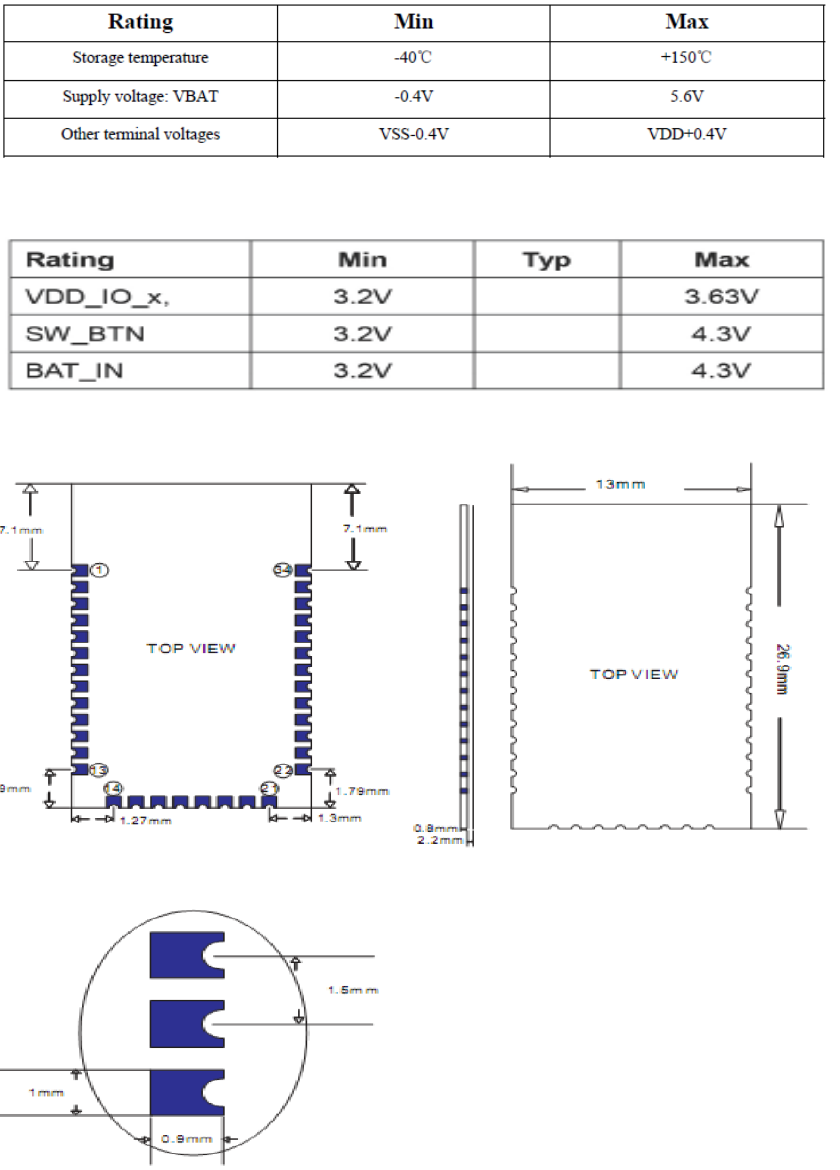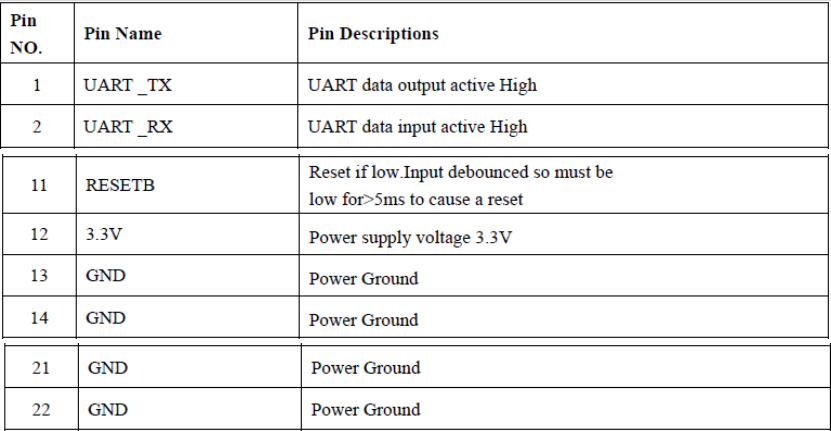User Manual
Page 1 of 5
User Guide
BLUETOOTH MODULE
Model: MS-BT002
1. Device Features
-Bluetooth standard device.
- Own power regulator 3.3V (Typical)
-Minimum External Components
-UART interface
-Support for 8Mbit External Flash Onboard
-Support for 802.11Co-Existence
-RoHS Compliant
2. Applications
This BT Modular is a highly integrated solution which is a Request for Limited Modular
Approval application. It includes a 2.4GHz digital transmit and receive, a base-band
processor, Band Pass Filter, 16MHz Crystal, and 8Mbit Flash memory. The BT Module
implements base-band processing supporting GFSK, π/4-DQPSK, 8-DPSK. This BT
Module also provides a user interfaces including UART, External interface supports LED.
Only data communication functions support according to BT standard device.
3. Key Features
Operating Frequency Band:2.402GHz -2.480GHz ISM band
Bluetooth Specification:V4.0 low energy which Compatible
with previous Bluetooth V3.0+EDR
Theoretical range in open field:Bluetooth Class II
Transmitter Power:+4dBm (Typical)
Host Interface:UART
Power Supply:3.3V(Typical)
Dimension:26.9mm (L) x 13 (W) mm x 2.2mm (H)

Page 2 of 5
4. Electrical Characteristic
Absolute Maximum Ratings
Recommend operation conditions
5. Mechanical Dimensions

Page 3 of 5
7. Pin Definition Descriptions
FCC Statement:
Federal Communication Commission Interference Statement
This equipment has been tested and found to comply with the limits for a Class B digital
device, pursuant to part 15 of the FCC Rules. These limits are designed to provide reasonable
protection against harmful interference in a residential installation. This equipment generates,
uses and can radiate radio frequency energy and, if not installed and used in accordance with
the instructions, may cause harmful interference to radio communications. However, there is
no guarantee that interference will not occur in a particular installation. If this equipment does
cause harmful interference to radio or television reception, which can be determined by
turning the equipment off and on, the user is encouraged to try to correct the interference by
one or more of the following measures:
• Reorient or relocate the receiving antenna.
• Increase the separation between the equipment and receiver.
• Connect the equipment into an outlet on a circuit different from that to which the receiver
is connected.
• Consult the dealer or an experienced radio/TV technician for help.
FCC Caution: Any changes or modifications not expressly approved by the party responsible
for compliance could void the user’s authority to operate this equipment.
This device complies with part 15 of the FCC Rules. Operation is subject to the following two
conditions: (1) This device may not cause harmful interference, and (2) this device must
accept any interference received, including interference that may cause undesired operation.
Page 4 of 5
FCC Radiation Exposure Statement:
This Bluetooth Module complies with FCC radio-frequency exposure guidelines set forth for
an uncontrolled environment.
This device is intended only for OEM integrators under the following conditions:
(1) According to FCC Part 15 Subpart C Section 15.212, the radio elements of the modular
transmitter must have their own shielding. However, due to there is no shielding for this
Bluetooth Module, this module is granted as a Limited Modular Approval.
(2) This module itself may not be marketed without the base board that contains the antenna.
This device has been designed to operate with an PCB antenna built-in the base board having
a maximum gain of 2dBi. Only this type of antenna may be used.
(3) Integration is typically strictly restricted to Grantee himself or dedicated OEM integrators
under control of the Grantee.
As long as 3 conditions above are met, further transmitter test will not be required.
However, the OEM integrator is still responsible for testing their end-product for any
additional compliance requirements required with this module installed (for example, digital
device emissions, PC peripheral requirements, etc.).
IMPORTANT NOTE: In the event that these conditions cannot be met (for example
certain laptop configurations or co-location with another transmitter), then the FCC
authorization is no longer considered valid and the FCC ID cannot be used on the
final product. In these circumstances, the OEM integrator will be responsible for
re-evaluating the end product (including the transmitter) and obtaining a separate FCC
authorization.
This module is intended for OEM integrator. The OEM integrator is still responsible for the
FCC compliance requirement of the end product, which integrates this module. Due to
missing shielding the module is strictly limited to integration by the Grantee himself or his
dedicated OEM Integrator.
Any changes or modifications not expressly approved by the manufacturer could void the
user’s authority to operate this equipment.
Declaration the Restriction of this Limited Module Approval:
According to FCC Part 15 Subpart C Section 15.212, the radio elements of the modular
transmitter must have their own shielding. However, due to there is no shielding for this
Bluetooth Module, this module is granted as a Limited Modular Approval. When this
Bluetooth Module is installed into the end product, a Class II Permissive Change or a New
FCC ID submission is required to ensure the full compliance of FCC relevant requirements.

Page 5 of 5
USER MANUAL OF THE END PRODUCT:
In the user manual of the end product, the end user has to be informed that the equipment
complies with FCC radio-frequency exposure guidelines set forth for an uncontrolled
environment.
LMA, professional installation, radiated emission measurements Module inside Host A Class
II Permissive Change or New Certification is not in general required here.
The end user has to also be informed that any changes or modifications not expressly
approved by the manufacturer could void the user's authority to operate this equipment.
If the size of the end product is smaller than 8x10cm, then additional FCC part 15.19
statement is required to be available in the user manual: This device complies with Part 15 of
FCC rules. Operation is subject to the following two conditions: (1) this device may not cause
harmful interference and (2) this device must accept any interference received, including
interference that may cause undesired operation.
LABEL OF THE END PRODUCT:
The final end product must be labeled in a visible area with the following" Contains TX FCC
ID: AZK-BT002 ". If the size of the end product is larger than 8x10cm, then the following
FCC part 15.19 statement has to also be available on the label: This device complies with Part
15 of FCC rules. Operation is subject to the following two conditions: (1) this device may not
cause harmful interference and (2) this device must accept any interference received,
including interference that may cause undesired operation.
Hereby, Meet (China) Ltd. declares that this Radio-Frequency peripheral is in compliance
with the essential requirements and other relevant provisions of Directive 1999/5/EC.